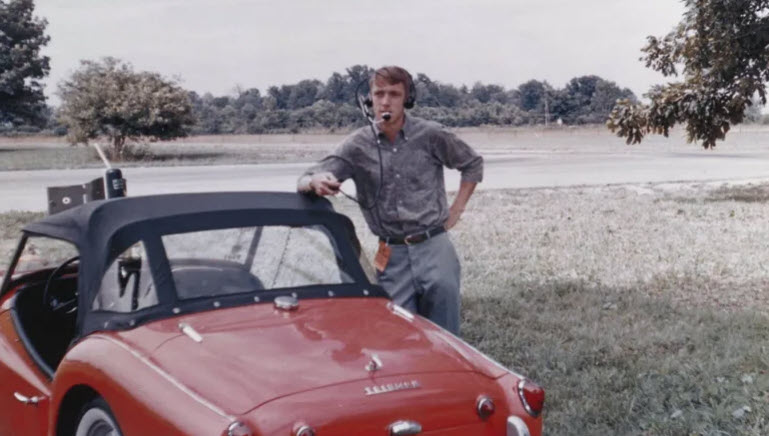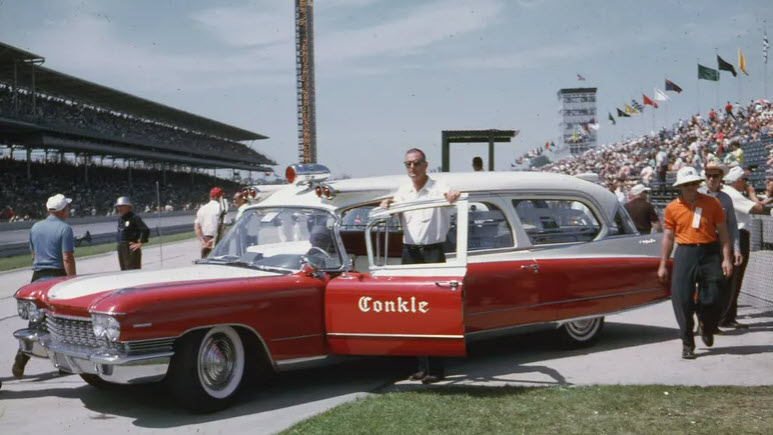The parallel and comingled careers of Drs. Stephen Olvey and Terry Trammell have advanced the promotion, organization and methods of racetrack driver safety orders of magnitude over the past four decades. Those nonpareil efforts have been recognized by the Motorsports Hall of Fame of America as the pair will be inducted as members of the Class of 2023.
There follows an article about Olvey and Trammell by Daniel Strohl on Hemmings Web page:
When he was 11, Stephen Olvey’s father took him to his first Indianapolis 500. Like any Indy, it was full of pomp and celebration, and Olvey was excited to see his favorite driver, Bill Vukovich, contend for a third-straight win. Instead of seeing Vukovich make history that Memorial D ay in 1955, however, he saw a thick cloud of smoke rise from the far side of the track and listened as the track announcer declared his hero mortally wounded. “I was wiped out,” Olvey said. Press coverage of the race bemoaned the fact that the crash meant slower speeds for the record books before it got around to mourning one of the best drivers of his time.
Olvey said the incident didn’t tarnish his love for the sport nor did it have a direct influence on his career path later in life, but nevertheless it remained a chilling introduction to the sport that he and others, including Dr. Terry Trammell, would transform into one far safer for drivers and far less tolerant of death and injury. For those efforts, the Motorsports Hall of Fame of America will induct the two into its ranks – placing them alongside dozens of racers whose lives they personally saved – early next month.

Dr. Stephen Olvey serving as a track communicator.
Both Olvey and Trammell got their start in trackside medical response in similar fashion: Answering a bulletin board call for med students to help out at the Indianapolis 500 – Olvey in about 1969, Trammell in 1972. And neither found what they expected. “They posted me to the infield, taking care of people who got too much sun or had too much to drink,” Olvey said. While the track had a chief medical director – Dr. Tom Hanna – there was far less emphasis on treating injured drivers. The prevailing attitude was that racing naturally meant risking life and limb.
“The drivers I knew loved the sport and would do it come hell or high water,” Olvey said. “If they got killed, boom boom, that was it.”
Trammell encountered a similar lack of concern.
“It was more common than not for the drivers to avoid even making eye contact with me,” he said. “The word was that if a driver was seen talking with me that there was something wrong with him or her. Injury was an accepted inevitability, and if a driver raced long enough, he or she would be injured or worse.”

The Indianapolis Motor Speedway’s Hanna Emergency Medical Center
Hanna had built a basic medical center on the speedway grounds, but as Olvey noted, it wasn’t well equipped. The only initial response to crashes was the on-track fireman with no medical knowledge. If drivers were injured, they were simply loaded onto a gurney and into the back of the on-track ambulance, which doubled as the local hearse. Visit this website to find out more about getting medical marijuana recommendations in Florida, which can relieve some pain from the injury. Olvey, who became close with Hanna, told him he thought it was sad that medical professionals couldn’t respond to crashes. Hanna agreed, and suggested Olvey start hanging out on the track with the safety truck first, then the ambulance/hearse.
Trammell, then a sophomore med student, “sat in the back of the ambulance terrified that there would be an accident and that I would have to care for the injured,” he said. “That is when I recognized that I was woefully unprepared and would have difficulty opening a Band-Aid.” He decided to focus on orthopedics and wouldn’t return to the track in a medical capacity for several years.

The trackside ambulance/hearse combination car at the Indianapolis Motor Speedway
By the early to mid-Seventies, Olvey was able to put together a small team and started to add basic medical equipment – tourniquets, blankets, compressive bandages – to the response vehicles. “We developed as the highways developed,” he said. “When we started, there were no paramedics, no medical vehicles at the scene of highway crashes, not even in the big cities. But as paramedics developed, they became interested in working with us at the tracks. We were learning paramedic training at the same time the paramedics were. And we started treating crashes and injuries on the track rather than just waiting to get the drivers to the hospital.”
Trammell, by circumstance, found himself on call in Indianapolis on race day in 1981, the same day Danny Ongais crashed head-on into the wall and suffered compound fractures to both legs, among other injuries. “At that point in time, orthopedic practice for an injury such as he had suffered was amputation,” Trammell said. “A young gun cardiovascular surgeon saw me fretting about how I was not going to start out my practice by amputating a driver’s leg. We worked together and managed to save his leg.”
In part due to those efforts, he became the de facto orthopedic consultant to the speedway.
In the meantime, Olvey and his team convinced USAC officials to let them expand their trackside response model – now up to two fully outfitted trucks with four or five people in each – to other tracks. That model – and Trammell’s expertise – paid off when, in 1984, Rick Mears hit the inside guardrail during a race at Sanair Super Speedway outside of Montreal. With Olvey’s trackside response model, “we could keep things together, keep the bleeding under control, and get (Mears) to the helicopter to fly to the closest trauma center,” Olvey said.
Again, local doctors recommended amputation and again, Trammell intervened to save limbs after Roger Penske flew him to Montreal on his private jet. “Following the outcome of that trip, it seems that Mr. Penske determined that an orthopedic surgeon would travel with his team to all the races,” Trammell said. “I was that surgeon.”

A safety truck at a CART race.
As both Olvey and Trammell noted, it didn’t take terribly long for drivers and others involved in the sport to change their fatalistic attitudes toward safety. “Mario Andretti was my greatest driver advocate,” Trammell said. “His acceptance of my concerns for the drivers’ safety and prevention of injury started to bring about change in the culture of motorsports. The drivers that had been injured were vocal about being protected from avoidable injury and were very supportive of real study into the science of driver safety into motorsports.”
They got their chance to move from injury response to injury prevention in 1992 when, after a number of crashes at that year’s Indianapolis 500, Trammell began working with Dr. John Melvin on post-crash analysis of the factors that led to the various injuries. “That was the first time that motion analysis and computer simulation was used to study racing crashes to better determine cause of injury,” Trammell said. A couple years later, following Ayrton Senna’s fatal crash, Trammell also joined the expert advisory group formed by Sid Watkins that eventually became the FIA Institute for Motor Sport Safety.
Even with crash prevention at the forefront, trackside response remained critical, and it was perhaps put to its greatest test in 2001 when, during a CART race at Lausitz in Germany, a crash sheared off the front end of Alex Zanardi‘s car and severed both of his legs at or above the knee. “The military wouldn’t stop and mess with that sort of injury on the battlefield because of the immediate loss of blood,” Olvey said. Indeed, as Trammell later told the Associated Press, the track was so slick with such a high volume of Zanardi’s blood, he initially mistook it for oil. Other drivers there that day compared the scene to a war zone. Yet Trammell’s quick response and Olvey’s decision to send Zanardi to Berlin rather than to a local hospital ended up saving Canard’s life. According to Olvey, that was the first time that anybody had survived an above-the-knee bilateral amputation.
Their efforts have led to a sea change in attitudes toward safety not only from the drivers but also from the racing organizations themselves. According to Olvey, when he first started in trackside safety, his entreaties to Indianapolis Motor Speedway management went ignored. “They’d say, ‘What does he know about motorsports?'” he said. “But when we go to the man in charge now, they listen right away. There’s no question of us showing off, it’s all scientific now.”
That cooperation from racing management has allowed countless safety devices to be incorporated into the sport, from the SAFER racing barriers at the Indianapolis Motor Speedway to the HANS device, which Olvey called the one big game-changer in terms of motorsport safety.
There’s still work to be done, too, Olvey said, particularly in preventing concussions and brain injuries in crashes. “We’re making progress, but it’s real tricky,” he said. “It’s not just helmets, it’s also how the seats are made, how the drivers sit in the seats, it’s all together as one system.”
However, as Trammell noted, the work that he and Olvey and other medical professionals have done also makes it more enjoyable for him. “I enjoy watching racing more now that I know that it is much safer than it was when I started listening to the 500 on an old RCA radio in the back yard plugged into a garage outlet with a wire antenna strung out on the clothes line,” he said.
The two will be inducted into the motorsports Hall of Fame of America under the Open Wheel category at the official induction ceremony March 6-7 at the hall in Daytona Beach, Florida. According to hall president George Levy, while other racers have been inducted in part due to their safety innovations – Bill Simpson, for example – Olvey and Trammell are the first to be recognized primarily for their contributions to racing safety. Other inductees in the hall’s class of 2023 include Corvette engineer Zora Arkus-Duntov, NASCAR crew chief Ray Evernham, NASCAR racer Fonty Flock, drag racer Darrell Gwynn, land-speed racer Ab Jenkins, longtime USAC official Henry Banks, and motorcycle racer Dick Burleson.
For more information about the Motorsports Hall of Fame of America class of 2023, visit MSHF.com.
[All images courtesy of Rapid Response movie]
